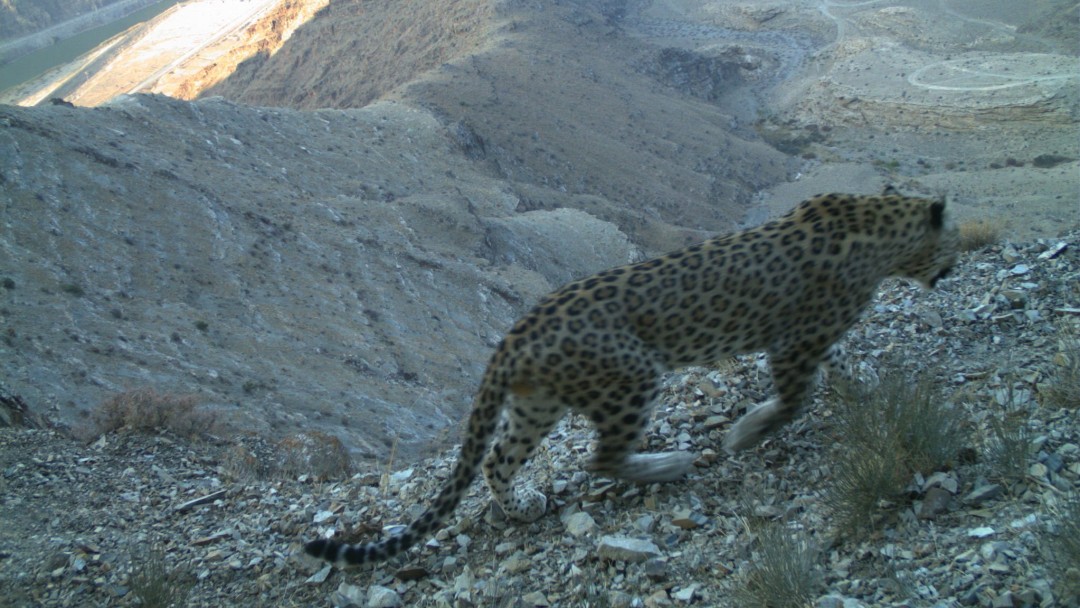News from 2018-06-25 / KfW Development Bank
The Caucasian leopard lives
The CNF nature conservation fund, which is now celebrating its 10th anniversary, has also contributed to these efforts

The Caucasian leopard is one of the most beautiful and rarest animals in Europe. And it hasn't completely vanished! About 100 animals roam the Caucasus to this day, but the species is seriously threatened with extinction. The majestic animal prefers habitats in remote regions which would also be under threat in the sparsely populated Caucasus if it weren't for active countermeasures, making conservation areas all the more important for its survival.
This is true not only for the leopard, but also for the Caucasian red deer, the European bison, the brown bear, the Caucasian black grouse and many other species. The region is one of the 35 most important "biodiversity hotspots" in the world thanks to its unique biodiversity. Situated between the Caspian Sea on one side and the Black Sea on the other, the isthmus is a biological hub roughly the size of France where many plant and animal species from Europe, Central Asia, the Middle East and North Africa can be found. No fewer than 6,400 vascular plants such as mosses or ferns grow here. The Caucasus has one of the highest percentages of endemic species in the temperate zone.
The Caucasus Nature Fund as an instrument for sustainable species conservation
But this natural diversity is under threat from humans because forests are being cut down, large roads and bridges are being built and agricultural activities are intensifying. The preservation of this unique natural heritage is one focus area of Financial Cooperation with the three Caucasus states Armenia, Azerbaijan and Georgia. For over 20 years, KfW has been supporting the establishment of nature conservation areas in the South Caucasus in close collaboration with WWF.
Ten years ago — in early June 2007 — KfW launched the Caucasus Nature Fund (CNF) on behalf of the German Federal Government to ensure that the conservation areas are managed effectively in the long term and that operating costs are available from the national budgets despite a lack of budget allocations. This fund ensures that operating costs can be paid, equipment bought, and park rangers compensated appropriately. As a result, conservation areas are operated efficiently, and fauna and flora are effectively protected so that populations can recover, and biological diversity is preserved in the long term.
Since its inception, the CNF has steadily expanded its funding activities: today, it contributes around EUR 1 million annually for better management of 16 conservation areas currently protected in the three countries, thus covering an area of more than 550,000 hectares. In addition to more efficient management of the parks, it also contributes to training for employees, the purchase of urgently needed equipment and fire trucks, effective monitoring systems for endangered species, and the promotion of eco-tourism.
Through KfW, the German Federal Government has actively supported setup and development of the CNF and has contributed more than EUR 32 million to the fund over the past ten years. Just last November, another EUR 3.5 million was added. The fund's Executive Director, Geof Giacomini, saw this latest contribution as a sign of "Germany's continued support for nature conservation" in the Caucasus.
Even more conservation areas, even more land
The CNF's legal form is a foundation consisting of an expense fund and a capital fund. The latter affords the CNF financial protection over the long term as only the interest income is used, the capital stock itself is retained. This allows it to take a long-term view in its work and help the region's conservation areas effectively achieve the aim of preserving their unique biological diversity over the next ten years.
The CNF will continue to intensify its activities: by 2020, it plans to support 20 of 30 conservation areas in the region, thereby protecting one million hectares of land — and saving countless animal and plant species from extinction in the process, including the Caucasian black grouse and the Caucasian leopard. "Over the past ten years, the fund has proven to be an important and impactful tool in long-term effective conservation," says Olaf Zymelka, Head of Division at KfW Development Bank. "This is what we are committed to."

Share page
To share the content of this page with your network, click on one of the icons below.
Note on data protection: When you share content, your personal data is transferred to the selected network.
Data protection
Alternatively, you can also copy the short link: https://www.kfw-entwicklungsbank.de/s/enzBWrMC.B0BA
Copy link Link copied